Home
"The Ships"
featuring
Chinese Junks
- and "the Boat People"
It is commonly accepted, that
the age of sail died out towards the end of the 1800's - - - -
However, - any sailor who has
navigated the great oceans of the World up through the 1960's and 1970's-,
cannot quite agree to that.
In the Indian Ocean you would
often meet large ships of the type the Europeans refer to as "dhows", -
with huge latin sails, and looking very much like the portuguese ships
that traded in these waters in the 1500's.
In Indonesia you could see
huge fleets of sailing ships with schooner rigs, - obviously copied from
the European schooner type -, and even in the port of the capital Jakarta
you could see rows and rows of beautiful schooners loading and discharging
their cargoes to and from the nations many remote islands.
And when navigating the South
China sea, you would often find yourself surrounded by 30 - 40 Chinese
junks.
They came in all sizes with
up to four masts, and was driven only by sails.
This is quite amazing to think
of - - - -
Ships has been around in China
for an awful long time, - we talk about 2 - 3000 years -, and there was
a time, when the Chinese were at least 5 - 600 years ahead of Europe when
it comes to ship design using watertight bulkheads.
Another important Chinese invention,
- the stern mounted rudder -, came even earlier and was first developed
in Europe in the 14th. century, - 1300 years later!
Also when it comes to sail
and rigging, the Chinese were far ahead.
They built ships with more
than one mast several hundred years before the Portuguese came up with
the same idea in Europe.
Since the 9th. century the
Chinese used the characteristic lugger sail on their big, oceangoing junks,
and could with this rigging sail very close to the wind, contrary to the
the Europeans, who had been satisfied with their huge square sails, which
were great as long as the wind came in from the aft, but not very efficient
when the wind came in from ahead.
Finally, - the most important
of all navigation instruments, - the compass -, was invented in China.
Therefore, - before the 15th.
century it is not wrong to say, that the Chinese were far ahead of the
Europeans in maritime matters. Their ships were simply bigger and better,
with their watertight compartments and a more efficient rigging distributed
on several masts.
But in the 15th. century, the
Chinese and the Europeans finally became equals when it comes to rigging,
since the Portuguese now had introduced the latin sail, and in addition
to that, the Europeans now also had the compass, and the stern mounted
rudder had already been introduced the century before.
Then the Europeans took the
lead, with improved knowledge of navigation, and better understanding of
wind, weather and the ocean currents - - -
But the Chinese junks sailed
on well into the twentieth century, - and we sailors marveled at the sight
of them, being it on the open ocean or navigating China's great rivers
as they had done for a thousand years - - - -
They were extremely beautiful
to look at, - often gaily painted -, with their sails spread out with long
flexible bamboo sticks, but as modern sailors we could not help to notice,
that from our point of view they were far from perfect with their too low
freeboard and high, square and bulky aft structure, that virtually begged
big storm waves to smash them, and the colourful lugger sail would of course
not have a chance towards the modern, triangular, very tall and narrow
"bermuda" type sail.
However, - this hopelessly
old fashioned rigging type did in fact have its advantages.
It was quite impressive to
see how fast the Chinese sailors actually could lower the bamboo supported
lugger sails.
In just a matter of a few seconds,
everrything, - sails and bamboo -, came crashing down, - a great
advantage in the South China Sea, where sudden typhoon winds often is experienced,
and you have to act fast before you capsize in the strong gusts of wind.
Also it was a bit disturbing
for us to know, that they had no keels, which would have a bad influence
on their ability to maintain course, but also this disadvantage could actually
be turned into an advantage, when navigating in shallow water as they would
often have to do on the long Chinese rivers and canal systems, - as well
as operating in shallow waters between the coastal islands.
With this design, the junks
could actually go everywhere, - deep ocean or on inland waterways -, and
that might be the answer to why they survived for so long time.
But eventually the junks disappeared
from the South China Sea, and it happened very fast, - it took just a few
decades, then they were all gone -, and today's sailors will not anymore
experience the thrill and joy of seeing traditional Chinese junks spreading
their wings on the South China Sea - - - - A great pity - -
-
In this section on Chinese junks,
I will show some of my many pictures of these wonderful ships - - -
They are long gone now, - but
certainly not forgotten.
Please enjoy - - -
Quick, direct links to all 9
pages:
Page
2 ,
Page 3 ,
Page 4 ,
Page 5 ,
Page 6 ,
Page 7 ,
Page 8 ,
Page 9
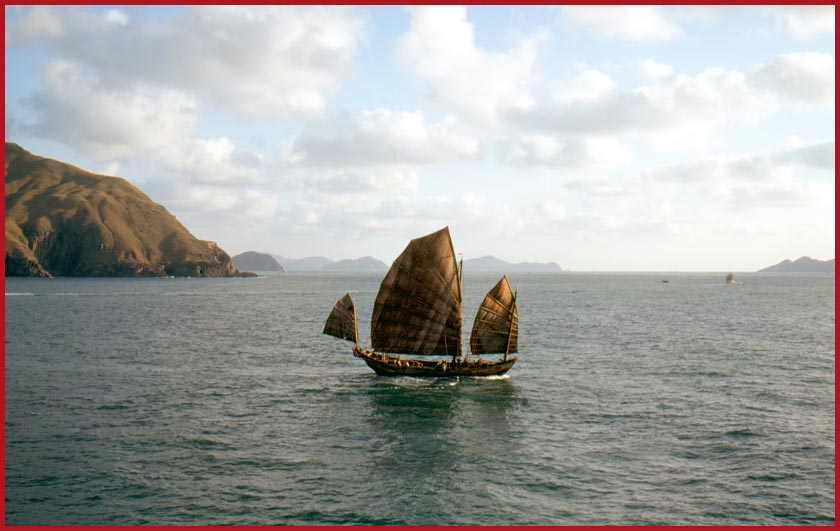
Chinese Junk
- photographed off Hong Kong
in 1969 -
(Photography by Karsten Petersen)
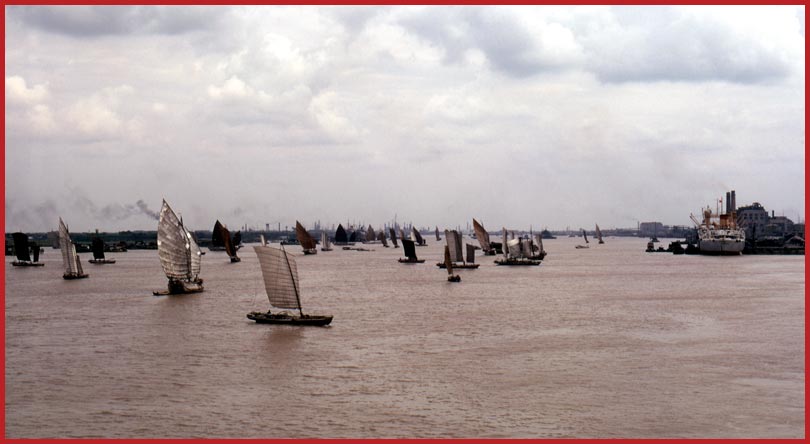
Chinese Junks
Numerous junks on the Huang-pu
river, China -,Sept. 1972
(Photography by Karsten Petersen)
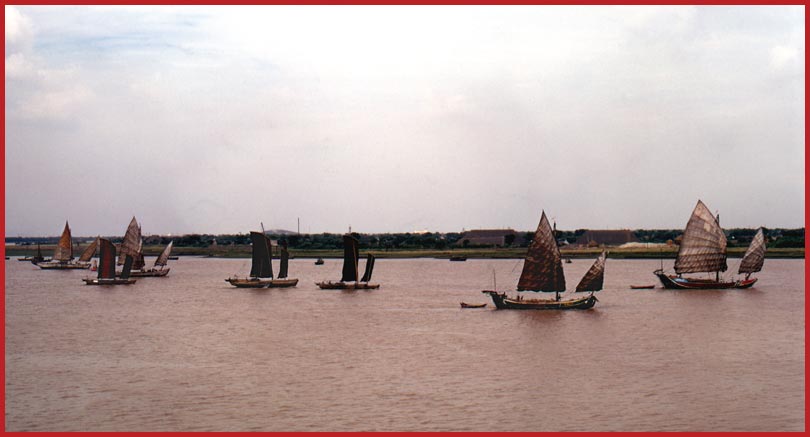
Chinese Junks
Junks on the Huang-pu river,
- China -, Sept. 1972.
(Photography by Karsten Petersen)

Chinese Junks
Junks on the Yangtze river,
- China -, Sept. 1972.
(Photography by Karsten Petersen)
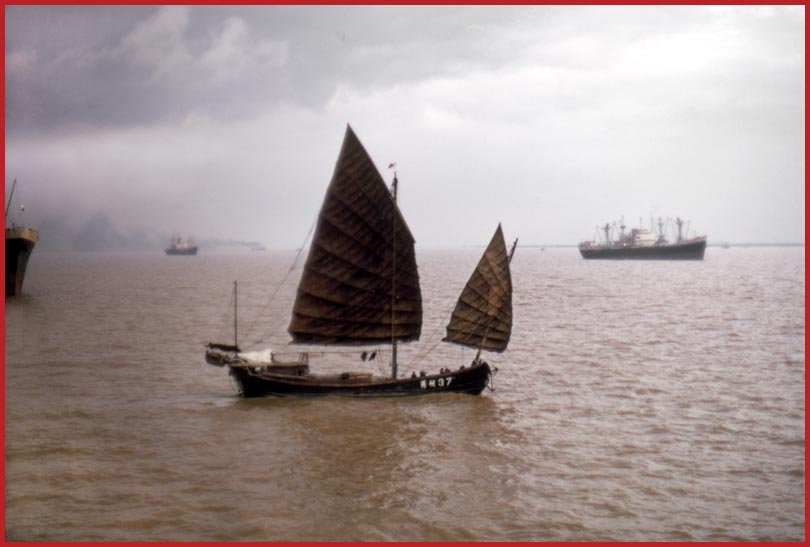
Chinese Junk
Junk and ships on the Yangtze
river, - China -,Sept. 1972.
(Photography by Karsten Petersen)
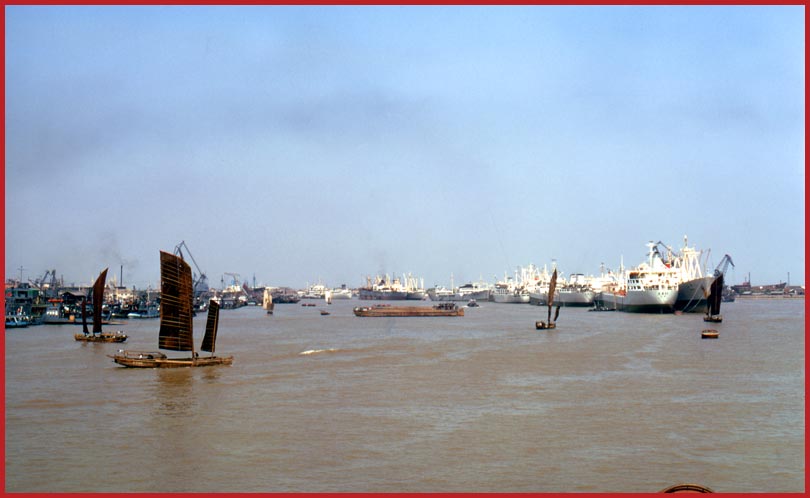
Chinese Junks
Junk traffic on the Huang-pu
river, - China -,Sept. 1972.
(Photography by Karsten Petersen)
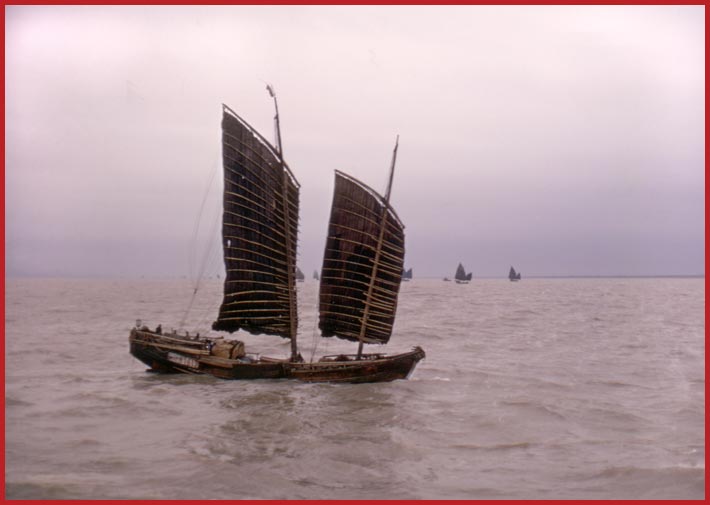
Chinese Junks
Junks at the Yangtze river
outlet, - China -, Feb. 1973.
(Photography by Karsten Petersen)
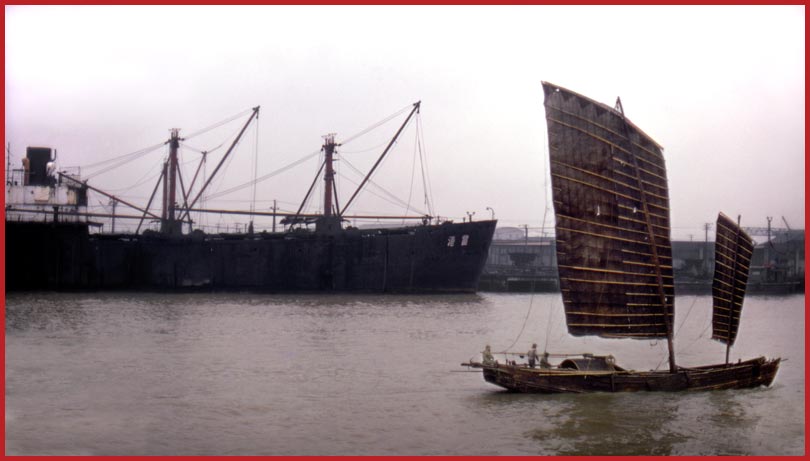
Chinese Junk
Junk and a "Liberty" ship on
the Huang-pu river, - China -,Feb.1973.
(Photography by Karsten Petersen)
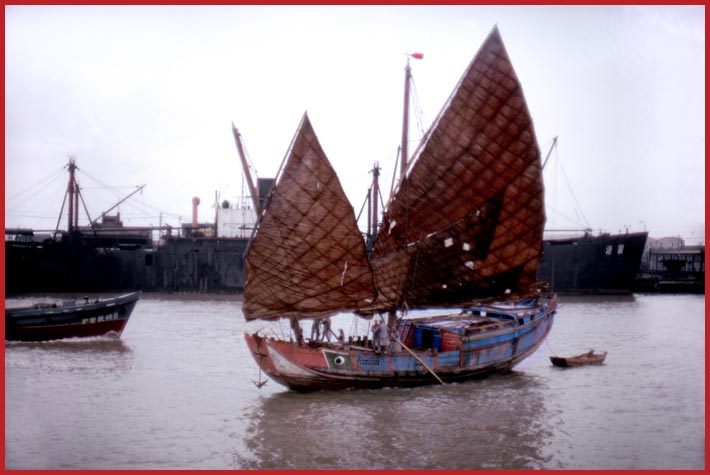
Chinese Junk
Painted junk on the Huang-pu
river, - China -, March 1st. 1973.
Take note of the big eye at
the bow, - and people rowing.
(Photography by Karsten Petersen)
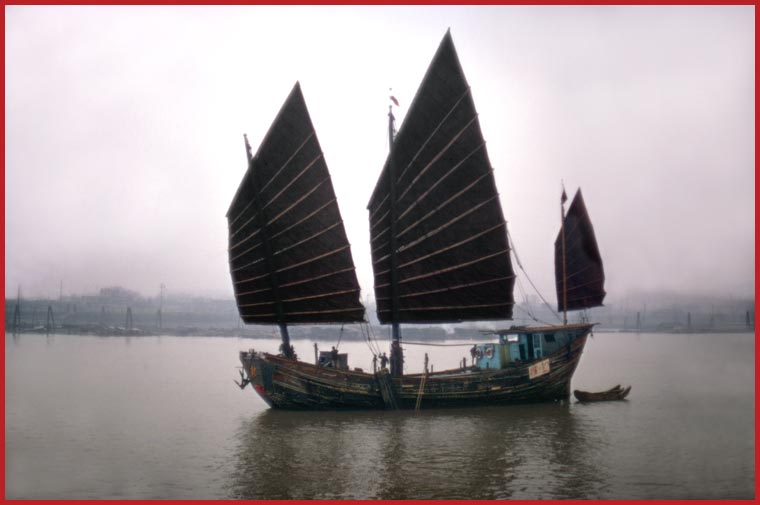
Chinese Junk
Junk in morning mist on the
Huang-pu river, - China -,March 4th. 1973.
(Photography by Karsten Petersen)
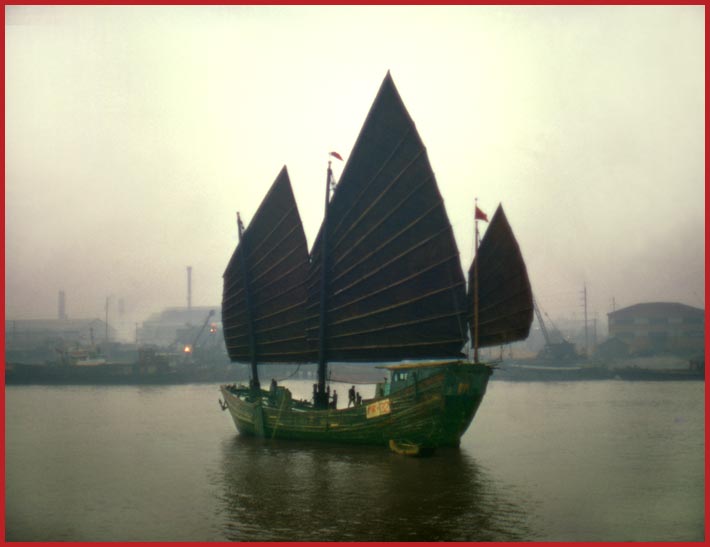
Chinese Junk
Junk in morning mist on the
Huang-pu river, - China -, March 4th.1973.
(Photography by Karsten Petersen)
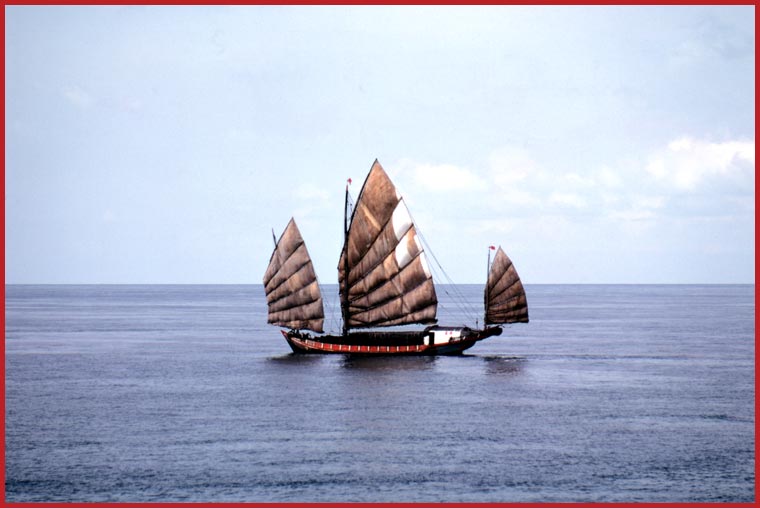
Chinese Junk
- in the South China Sea, April
1973 -
(Photography by Karsten Petersen)
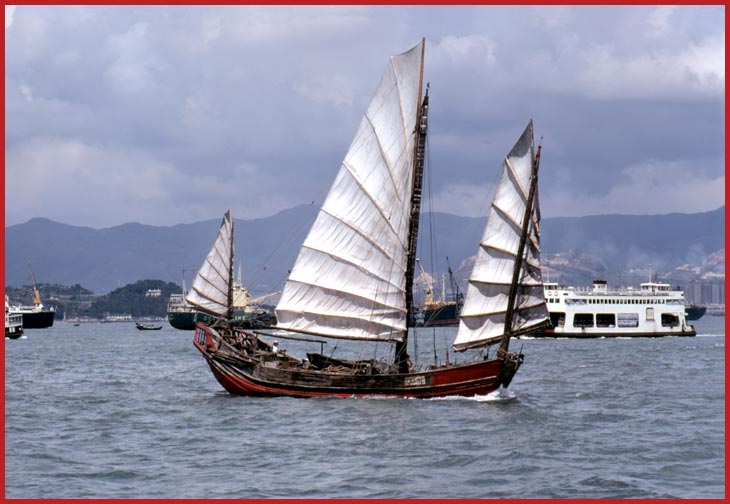
Chinese Junk
In Hong Kong's busy harbour,
Oct. 1973.
(Photography by Karsten Petersen)
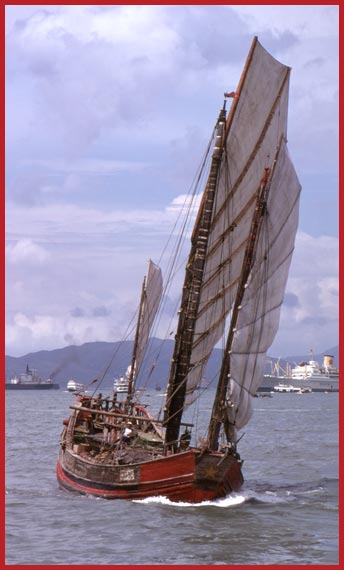
Chinese Junk
In Hong Kong harbour, Oct.
1973.
(Photography by Karsten Petersen)

Chinese Junk
Same as above, - detail -,
Hong Kong, Oct. 1973.
(Photography by Karsten Petersen)
Floating cities of Chinese junks???
Yes indeed!
In Hong Kong, - both on the
island itself as well as on the mainland and the outlying islands -, there
are several typhoon shelters, where small ships and fishing vessels can
seek shelter during the typhoon season.
In the mid 19 hundreds, several
of these typhoon shelters were actually not only used as refuges during
typhoons, but were in fact floating cities of junks, of which many would
never go to sea again, but just stayed there, permanently moored until
they rotted away and sank - - -
The biggest of these floating
cities could be found in Aberdeen Harbour between Hong Kong Island and
Ap Lei Chau.
Here lived about 20.000 "boat
people" on about 3000 junks. They are the Tanka- and Hoklo people, - a
certain group of fishermen, that traditionally preferred to live permanently
on their boats instead of living in apartments ashore.
There are still "boat people"
in Hong Kong, but the Hong Kong government has for long time tried to encourage
them to leave their boats and resettle ashore by building housing estates
for them as well as schools and facilities for their children. And slowly
but surely the fishermen have been transformed into factory workers as
their typhoon shelters are disappearing when harbour areas are being reclaimed
for city development - - -
Nobody forced the "Boat People"
to resettle ashore, - it was their own choice -, and probably a wise choice,
since the floating cities were actually a form of sea based slum, offering
only an inconvenient lifestyle.
The floating cities were , -
however -, extremely interesting to visit and explore, and seen from that
angle, it is actually a pity that they are disappearing - - - the world
becomes a little bit less colourful without them - - -
The following pictures are from
Aberdeen Harbour at its peak in the seventies - - -
Visitors to Hong Kong will
not experience this sight any longer, - the floating city of junks are
long gone - - -
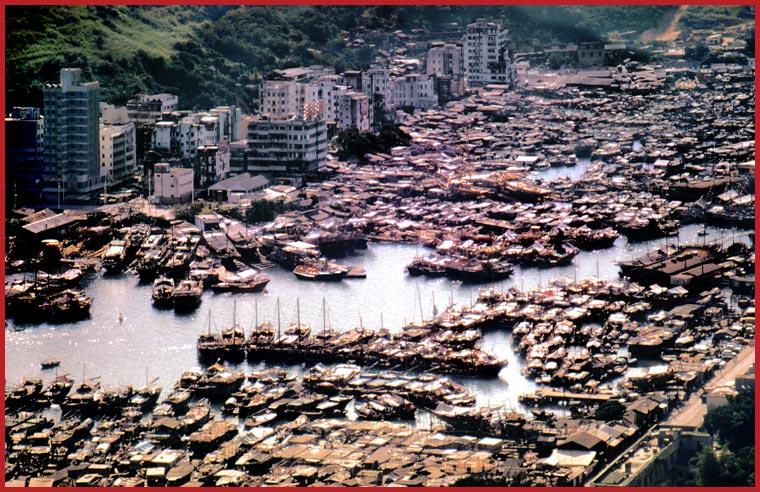
Chinese Junks
A sight never to be seen again!
The very large assembly of
junks at Aberdeen Harbour, Hong Kong, - Autumn 1973.
(Photography by Karsten Petersen)

Chinese Junks
The yards at Ap Lei Chau island,
Aberdeen Harbour, where lots of junks were built, - autumn 1973.
(Photography by Karsten Petersen)
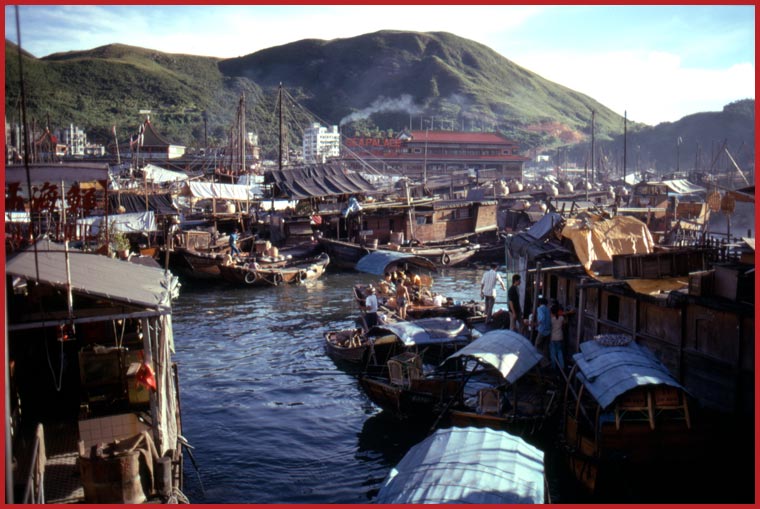
Chinese Junks
Aberdeen Harbour with its floating
city of junks, Hong Kong, - autumn 1973.
The well known, - and huge
-, floating restaurants in the harbour are seen in the background
- -
(Photography by karsten Petersen)
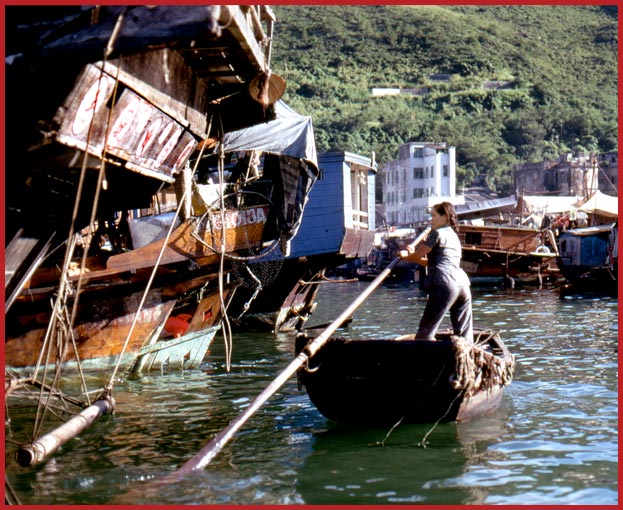
Chinese Junks
Sampan between junks in Aberdeen
Harbour, Hong Kong, - autumn 1973.
(Photography by Karsten Petersen)
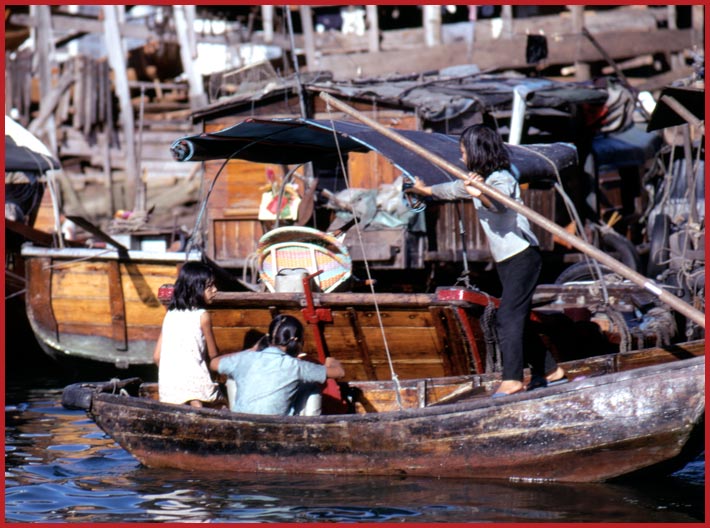
The "Boat People"
Life in the floating junk village
in Aberdeen Harbour, Hong Kong, - autumn 1973.
(Photography by Karsten Petersen)
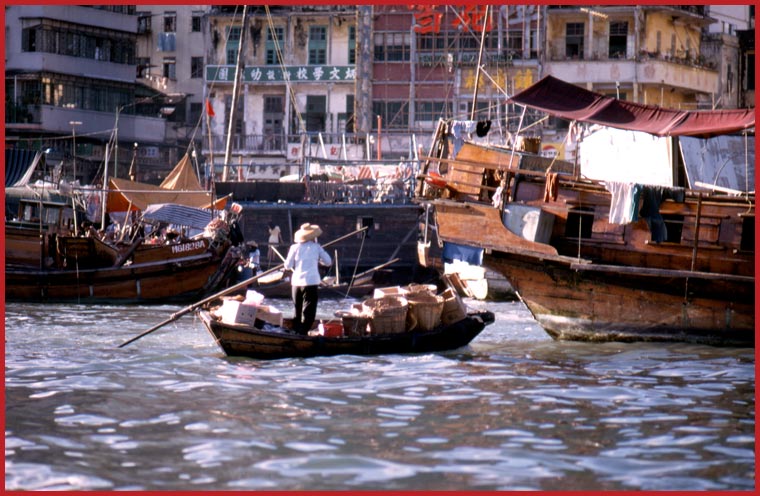
Chinese Junks
Life in the floating village,
Aberdeen Harbour, Hong Kong, - autumn 1973.
(Photography by Karsten Petersen)
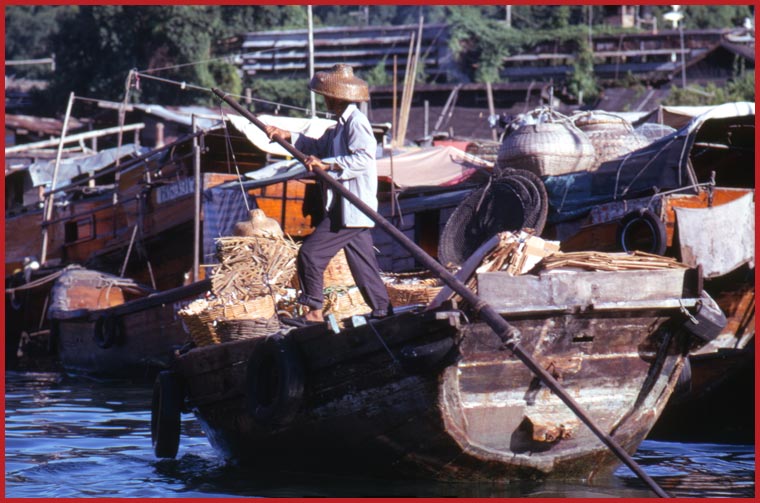
The "Boat People"
Boatman navigating his sampan
between the anchored junks, Aberdeen Harbour, - autumn 1973.
(Photography by Karsten Petersen)
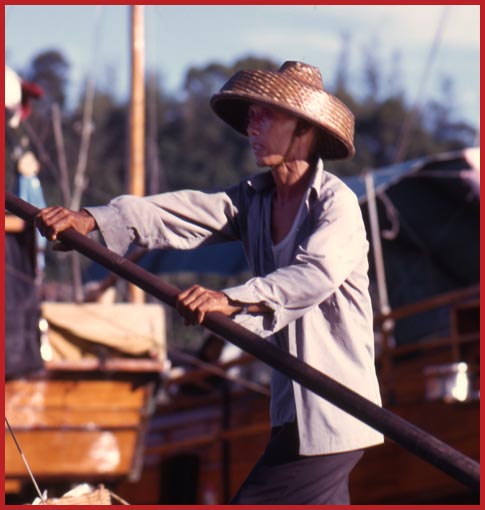
The "Boat People"
- boat man, Aberdeen Harbour,
Hong Kong, - autumn 1973 -
(Photography by Karsten Petersen)
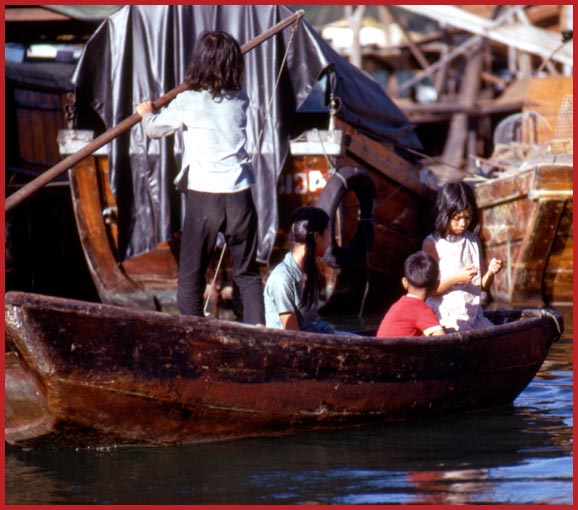
The "Boat People"
Children of the "Boat People",
Aberdeen Harbour, Hong Kong, - autumn 1973.
(Photography by Karsten Petersen)
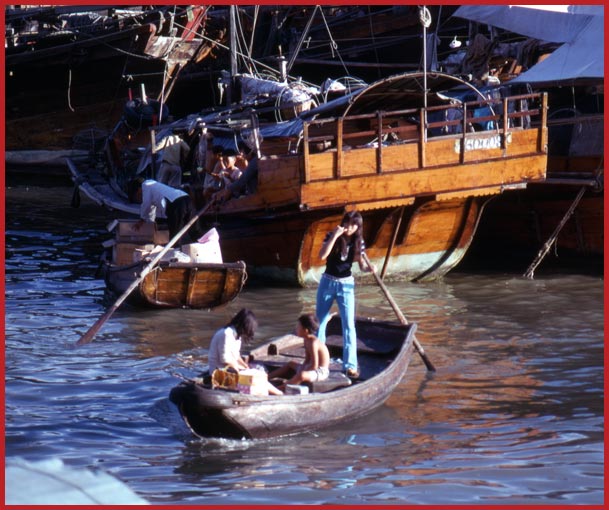
The "Boat People"
Sampan traffic everywhere,
- Aberdeen Harbour, Hong Kong, - autumn 1973.
(Photography by Karsten Petersen)
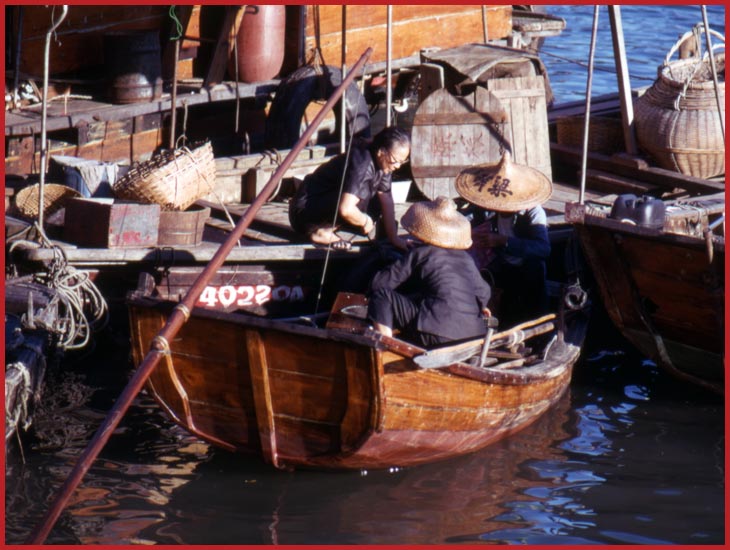
The "Boat People"
- at Aberdeen Harbour, Hong
Kong, - autumn 1973 -
(Photography by Karsten Petersen)
Click here for "Chinese
Junks" page two -
Back to "The
Ships"
Page initiated: Sept.29.2006
Updated......: Dec.10.2006
Dec.11.2006
Dec.12.2006
Dec.16.2006
Jan.11.2007

























